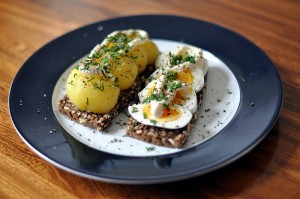Eating Danish Posted by Bjørn A. Bojesen on Jan 26, 2014 in Traditions
Some people say that danskere snakker med en kartoffel i munden (Danes talk with a potato in their mouth). While I would never recommend that you scorch yourself just to get the words right, there might be some truth to the saying… Your traditional Dane does eat a lot of kartofler (potatoes), and maybe eating like a native will bring you in the mood to talk like one… Here’s a quick outline of the typical måltider i Danmark (meals in Denmark):
Morgenmad [MOARNmath] is the early morning meal, eaten before people tager i skole/tager på arbejde (go to school/go to work – literally ”take…”). Unlike the ”coffee-and-croissant breakfast” in some countries, morgenmad is a really important meal in Denmark. People think it’s important to start the day ”fully loaded”, so they usually take their time consuming things like juice [dyooce], kaffe [KAHfeh], the [teh], mælk [melk], youghurt [YOOGoort] or milk with cereals like cornflakes [kourn-flex] or mysli [MEEslee] (muesli) and slices of brød [brerth] (bread) topped with margarine/smør (butter), ost (cheese) or syltetøj/marmelade (jam). On their days off, Danes traditionally buy morgenbrød (”morning bread”) – miniature ”pastries” including rundstykker, a kind of ”bread rolls”.
Frokost [FROHkost] can be compared to lunch in the English-speaking countries. Around noon, Danes gather in their homes or workplaces for another round of madder [MATH-or] (topped slices of bread) and typical drinks like milk or juice. By now, the pålæg (”the stuff you lay on bread”) has increased in range, including things like spegepølse [SPIEeh-perl-seh] (salami), leverpostej [LEVorpost-eye] (liver pâté) and agurk [aGOORK] (cucumber). (Hot food is consumed in some workplaces and constitutions, but it’s still not the norm.) By the way, ordinary Danish bread comes in two main ”flavours”: the dark, everyday rugbrød (RUEbrerth) or ”rye bread”, and the less coarse, ”dessert-ish” franskbrød [FRANSbrerth] (literally ”French-bread”). Many foreigners think that rugbrød has a strange taste (a bit ”bittersweet”, maybe), but Danes love it!
Aftensmad [AFTnsmaath] or ”evening meal” is the main meal of the day. Around 18 ’o clock the whole family gathers for a hot meal. Danes in 2014 are extremely cosmopolitan, so they eat the most diverse food for their aftensmad: Italian pizzaer and salat, American hamburgere and pomfritter (French Fries), Japanese sushi, Chinese and Thai wokmad (wok food), Middle-Eastern shawarma… Traditional Danish dishes like kartofler og frikadeller (potatoes and Danish-style meat-balls) are often eaten, too.
I think one of the most special things about food culture in Denmark is that we make so much of our food ourselves! Since the climate is often cold (and the prices a bit steep!), eating out is much less common here than in countries like Spain or the US. Every self-respecting Danish household has a large kitchen, cooking gear, kogebøger (cooking books)… Both women and men pride themselves in their cooking skills, and in many families, the duties of aftensmad are shared, so that one evening mor (mum) is the cook, the next evening far (dad) is the one carrying the forklæde (apron).
I’ve heard foreigners complaining that danskere spiser hele tiden (Danes eat all the time). Well, I won’t dispute that! 🙂 But let’s leave it there. There’s no need to focus too much on all the ”in-betweeners”, like brunch/mokost, eftermiddagskaffe (afternoon coffee), natmad (”night food”), slik (candies, sweets) and kaffe og kager (coffee and cakes) every time somebody is celebrating their fødselsdag (birthday)…

Build vocabulary, practice pronunciation, and more with Transparent Language Online. Available anytime, anywhere, on any device.
About the Author: Bjørn A. Bojesen
I was born in Denmark, but spent large parts of my childhood and study years in Norway. I later returned to Denmark, where I finished my MA in Scandinavian Studies. Having relatives in Sweden as well, I feel very Scandinavian! I enjoy reading and travelling, and sharing stories with you! You’re always welcome to share your thoughts with me and the other readers.




